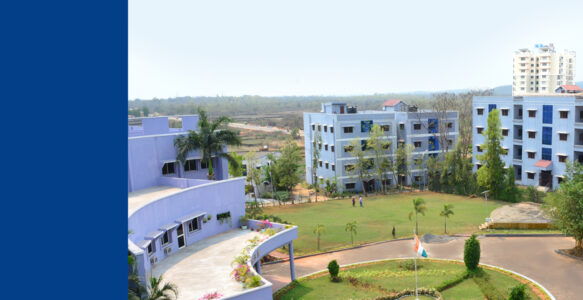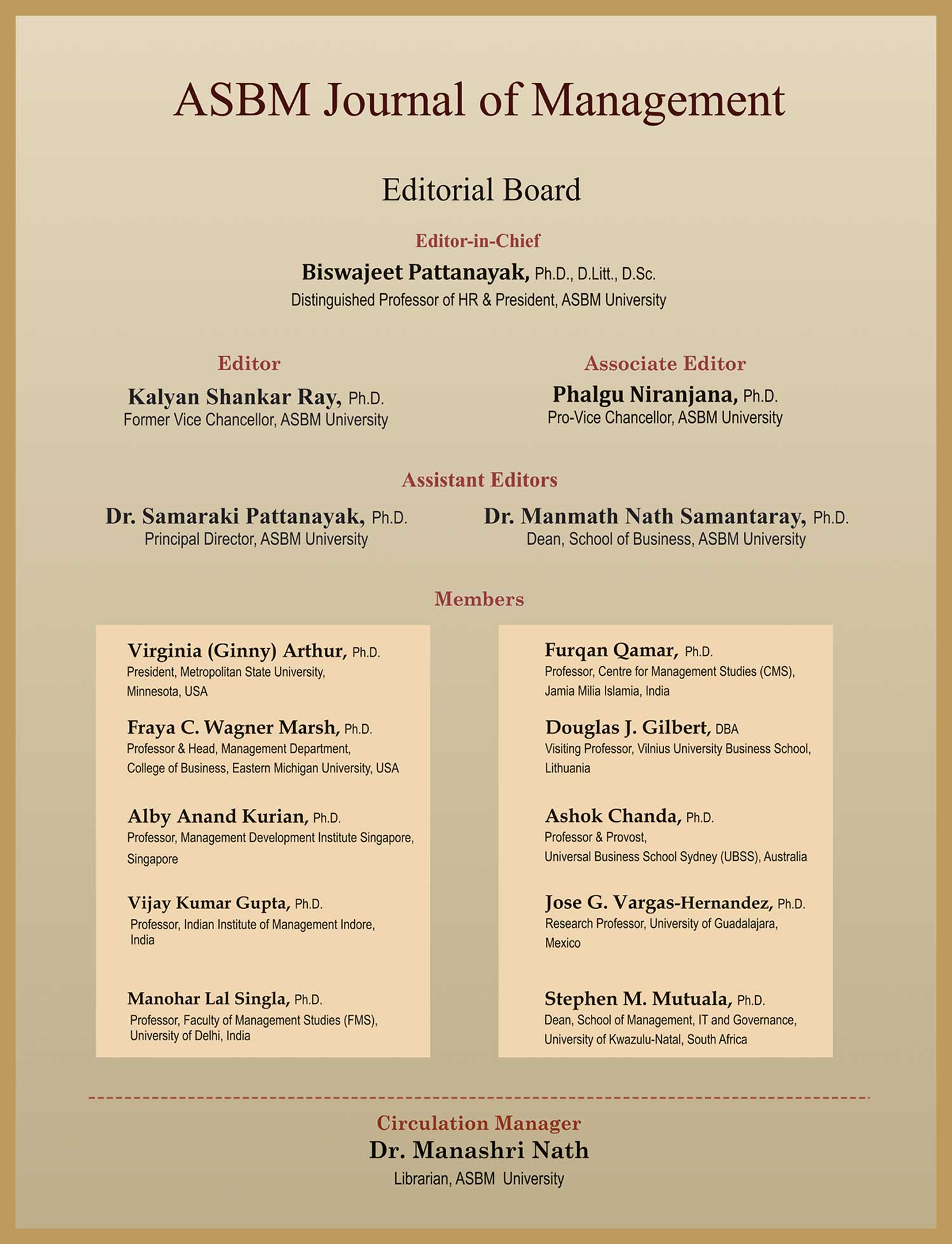CURRENT ISSUE
PUBLICATION AND ETHICS POLICY
The Journal ASBM Journal of Management is a bi-annual publication of ASBM University devoted to studies on management, social sciences and related disciplines. It publishes research based articles (both empirical and conceptual), case studies and book reviews, and invites contributions from thought leaders in all walks of life – academics, research, industry, business, administration and social work. The full text of the journal is included in EBSCO Host Database (USA) and ProQuest (USA). ASBM Journal of Management is in publication since 2008 and is published in hard copy.
Objective The basic objective of the journal is to disseminate innovative ideas and research results in different aspects of management, and thereby to contribute to management practice. It also aims at bringing academics closer to industry by developing congruence between theory and practice. Thus ultimately the journal expects to foster professionalism in organisational management.
Journal’s Policy The journal’s policy revolves around high ethical standards, professionalism and qualitative publication. The Editorial Board adheres to ethical principles in all activities related to the journal – publication decision, fair play, peer review, editorial responsibilities, confidentiality and standards expected of the reviewers and the authors.
All the manuscripts are subjected to blind peer review. No publication or processing fee is charged from the authors. Absolute confidentiality is maintained with regard to the status of the manuscripts and the review comments. Steps are taken to avoid conflict of interest. Moreover, to do away with any market perception of unfair treatment in selection of articles for publication, the journal does not accept in-house articles, i.e., articles authored by the faculty members, researchers or students of ASBM University, as a matter of policy.
Publication Decision Publication decision is based on originality of the article, clarity of thought, validity and relevance of the study, contribution to the discipline and review comments, subject of course to the scope and objectives of the journal. The editors scrupulously follow the tenets of fair play and the manuscripts are evaluated without any consideration to the authors’ caste, creed, community, nationality, gender, religion, ethnic origin, citizenship etc. Of course, legal requirements, such as libel, copyright infringement and plagiarism, are duly taken into consideration.
Review Policy All the articles received for publication are subjected to blind peer review. The authors remain unknown to the reviewers and so are the reviewers to the authors. The journal also does not publish or divulge the names of its reviewers. Confidentiality is maintained and the review comment is informed to none other than the corresponding author.
Responsibilities of the Editor Publication decision is taken by the editor in consultation with the editorial team, and so ultimately, it is the editor who remains accountable for anything that is published in the journal. She/ he is bound by the publication policy of the journal and the principles of fair play.
It is the responsibility of the editor to give constructive suggestions on the manuscripts, in addition to the review comments, regarding content, form of presentation, language, reference etc. Thereby the journal helps the authors – specially the new authors – to improve the quality of their work. The editor and the editorial staff maintain strict confidentiality about the manuscripts received for publication and do not disclose any information to anybody other than the corresponding author, the reviewers, the editorial team and the publisher, as appropriate.
The manuscripts received by the journal are regarded as privileged information. The editor and the editorial team are expressly prohibited from using such information for their own research and publication without express permission of the author and due acknowledgement. Thereby the journal avoids any conflict of interest.
Responsibilities of the Reviewers/ Referees The basic responsibility of the reviewers/ referees is to assess the manuscript referred to them with objective standards and thereby help the editor in taking decision regarding publication. They are requested to give specific and constructive comments, so that the quality of the article can be improved, if possible.
If any referee/ reviewer feels constrained to review the research reported in a manuscript or has any other constraint, she/ he should promptly withdraw from the review process. She/ he should also avoid conflict of interest by treating the manuscript as confidential and by not using any privileged information therein for her/ his own research and publication.
Responsibilities of the Authors The authors are advised to submit for publication their original research work, subject to the guidelines of the journal. They must ensure that the submitted article is originally written by them without any plagiarism whatsoever. They must appropriately cite all referenced material and also acknowledge any concept or idea that has been borrowed from other publications or has influenced their work. Underlying data must be correct and must be represented accurately in the article.
The authors must avoid multiple, concurrent or redundant publication. The same article must not be submitted to more than one journal simultaneously, nor should the same research be used to write more than one article.
If and when an author discovers any significant error or inaccuracy in her/ his own article published in ASBM Journal of Management, she/ he must forthwith inform the Editor and cooperate with the journal to retract or correct the publication.
Guidelines for Authors
Author’s Certificate & Declaration
ASBM Journal of Management : ASBM Journal of Management strongly believes in publication ethics and does not accept or condone any plagiarism. The authors are requested to ensure and warrant that the material submitted for publication is original work and is not an infringement of any existing copyright or proprietary right, nor does it amount to any invasion of privacy or libel. Manuscripts are accepted with the clear understanding that the authors will indemnify, defend and hold ASBM Journal of Management harmless from any damage, expense and cost against any breach of such warranty.
Publication Ethics – The authors are requested to refer to the Publication and Ethics Policy of the journal given separately and comply with it.
Length of the main text (including reference) –
a) Research paper – 5,000 to 10,000 words
b) Case study – 3,000 to 5,000 words
b) Book review – 1,000 to 1,500 words
Basic Formatting of the Manuscript –
- Cover Page – Should contain the title of the paper, full name, institutional affiliation, correspondence address, email id and contact phone number of all the authors. In case of joint authors, the name of the corresponding author should be clearly mentioned.
- Title – Bold typed and centred in upper and lower case; Font – 14 Point Times New Roman
- Abstract – Should contain the summary of the paper with its conclusions in not more than 150 words. It should be followed by 4-5 keywords.
- File – MS Word
- Font – Times New Roman
- Font Size – Title (14) , Text (11) , Heading (12 – Bold) & Sub Heading (11- Bold)
- Headings – Bold faced in upper and lower case; Aligned left
- Spacing – Single space in single column
- Margin –1 inch each for top, bottom, left and right
- Notes – Foot notes should not be used. The end notes, if unavoidable, should be minimised. All notes should be numbered serially in the text and should be detailed at the end of the paper before Reference.
- Page Numbering – All pages starting with Abstract page
Spelling and Numerical Usage –
- Spelling – British spellings should be used, rather than American (e.g., ‘Programme’ not ‘Programme’, ‘labour’ not ‘labor’, ‘colour’ not ‘color’ etc.).
- ‘s’ or ‘z’ – ‘S’ spelling should be used, instead of ‘Z’ in words ending with ‘ise’, ‘ised’, ‘isation’ etc. (e.g., ‘organise’ not ‘organize’, ‘recognise’ not ‘recognize’, ‘realised’ not ‘realized’, ‘civilisation’ not ‘civilization’ etc.).
- Numerals – Numbers from ‘one’ to ‘nine’ to be spelt out, while 10 and above to remain in figures. However, only figures should be used for exact measurement (e.g., 3 km., 9%). ‘Thousand’ and ‘million’ should be used, instead of ‘lakh’ and ‘crore’
Quotations, Notes, Tables and Figures – –
- Quotations should be mentioned within single quotes (i.e., inverted commas like ‘…..’); double quotes (“…..”) should be used while placing quotations within single quotes. Quotations of more than 45 words should be placed in a separate paragraph indented from the main body of the text. All quotations should be accompanied by appropriate citations and must have details in the reference section.
- Foot notes should not be used. The end notes, if unavoidable, should be minimised. All notes should be numbered serially in the text and should be detailed at the end of the paper before Reference. Notes must contain more than a mere reference.
- Tables, figures, graphs and charts should be drawn in MS Word file in black and white, and should be serially numbered in Arabic numerals (e.g., 1, 2, 3 etc.) with brief title/ caption. A legend should be given to explain the symbols, abbreviations and terminology used. The source must be mentioned. These should be placed in the main body where they belong. Graphs and charts should fit the width of 1 or 2 columns.
- All photographs and scanned images should have a resolution of minimum 300 dpi and 1,500 pixels and their format should be TIFF or JPEG. Due permission should be taken for copyright protected material. Even for photographs/ images available on the public domain, it should be clearly ascertained whether or not their reproduction requires permission. No power point slide or screen grabs should be used.
Reference – All the sources, which have been cited in the main text, should be listed in the Reference section alphabetically. The style adopted by the American Psychological Association (APA) should be followed. Some sample entries are given below –
a) Basic format for a book with single author :
Wood, N.V. (1995). Perspectives on argument. Englewood Cliffs, NJ: Prentice Hall.
b) Basic format for a book with two or more authors: Hawley, J., & Tilghman, C. (1992). Getting down to specifics. New York : Harper Collins.
c) Edited Book:
Stanford, J. A. (Ed.) (1993). Connections: A multicultural reader for writers. Mountain View, CA: May field Publishing Company.
d) Chapter in an edited book:
Torres, M. (1993). Crossing the border. In J. A. Stanford (Ed.), Connections : A multicultural reader for writers (pp. 73 – 77). Mountain View, CA : Mayfield Publishing Company.
e) Article in a journal :
Klimoski, R., & Palmer, S. (1993). The ADA and the hiring process in the organizations. Consulting Psychology Journal : Practice and Research, 45 (2), 10 – 36.f)
f) Unpublished Thesis :
Gale, L. (2000). The relationship between leadership and employee empowerment for successful total quality management. Unpublished PhD thesis, University of Western Sydney.
g) Magazine article :
Carver, K. L. (1993, February 9). Mind over matters. Management Magazine, 62, 71-74.
h) Newspaper article (available in print)
Berkovic, N. (2009, March 31). Handouts may not be sent: Tax office seeks quick resolution of High Court challenge. The Australian, p. 5.
i) Newspaper article (from electronic database)
Wentworth, W. C. (1984, January 24). Why we need a permanent base on the moon. The Sydney Morning Herald, p. 11. Retrieved from http://archives.smh.com.au/index.php
j) Unpublished Thesis retrieved online:
Gale, L. (2000). The relationship between leadership and employee empowerment for successful total quality management. Unpublished PhD thesis, University of Western Sydney. Retrieved from http://handle.uws.edu.au:8081/1959.7/28037
k) Document on the Internet:
Este, J., Warren, C., Connor, L., Brown, M., Pollard, R., & O’Connor, T. (2008). Life in the clickstream: The future of journalism. Media Entertainment and Arts Alliance. Retrieved from http://www.alliance.org.au/documents/foj_report_final.pdf
l) Document on the Internet, no author, no date:
Developing an argument. (n.d.). Retrieved March 30, 2009, from http://web.princeton.edu/sites/writing/Writing_Center/WCWriting Resources.htm
m) Web page on the internet, organisation as author:
The Turning Page Bookshop. (2000). Business profile. Retrieved from http://www.theturningpagebookshop.com.au/
n) Government report (online)Department of Health and Ageing. (2008). Ageing and aged care in Australia (Publication No. P3-4147). Retrieved from http://www.health.gov.au/internet/main/ publishing.nsf/Content/BFE46F21A3241ECBCA2574BE001A6E06/$File/Ageing_and_Aged_Care.pdf
Accuracy of Content – Underlying data must be correct and must be represented accurately in the article.Contributions are accepted on the strict understanding that the author is responsible for the accuracy of all opinions, technical comments, factual reports, data, figures, illustrations and photographs.
Permission – Responsibility for obtaining permission to use any material under copyright lies with the author(s). Ownership should be clearly acknowledged.
Publication Fee – No review or publication fee is charged from the contributors.
Submission of manuscript – The contributors are requested to mail the soft copy of the material to the Editor, followed by a hard copy. All manuscripts should be accompanied by a certificate-cum-declaration in hard copy in the specified format. It should be signed by all the authors. Manuscripts and editorial correspondence should be addressed/ e mailed to:
The Editor, ASBM Journal of Management,
ASBM University,
Shiksha Vihar, Bhola (Chandaka), ASBM Post Office, Bhubaneswar (India) – 754012
E-mail:[email protected], Website : https://www.asbm.ac.in/asbmjournal
Tel: 0674-2374801/ 02/ 03/ 04/ 05, Fax: 0674-2374900,
Policy against simultaneous submission – Authors should ensure that the manuscript submitted to ASBM Journal of Management is not simultaneously submitted to any other journal or publisher. Similarly, it should not be submitted anywhere else during the pendency of the review process, without specific written permission from the Editor of ASBM Journal of Management.
Acceptance – Manuscripts, which do not conform to the above guidelines, will not be considered for publication. All contributions will be subjected to blind review process. If necessary, the authors will be requested to make suitable change/revision/alteration. The Editors reserve the right to select or reject any article, and also to edit any material selected for publication, including the title. Rejected articles will not be returned.
Copyright – Once a manuscript is accepted by, or published in, ASBM Journal of Management, it becomes the property of ASBM University. Copyright for all papers/ materials published in the journal and/ or used in any format vests in the Editor/ Publisher of ASBM Journal of Management.
Error or Inaccuracy – If and when an author discovers any significant error or inaccuracy in her/ his own article published in ASBM Journal of Management, she/ he must forthwith inform the Editor and cooperate with the journal to retract or correct the publication.
Subscription Details:
Request for subscription should be sent to : The Circulation Manager, ASBM Journal of Management, ASBM University, Shiksha Vihar, Bhola (Chandaka), ASBM Post Office, Bhubaneswar – 754 012, Odisha, India
E mail: [email protected]
Phone: 0674-2374833/801/802/803/804/805, Fax: 0674-2374900.
The request should contain the name/ designation of the subscriber with full postal address, and should be accompanied by appropriate remittance through demand draft/ cheque drawn on any scheduled commercial bank in favour of ‘ASBM University’ payable at Bhubaneswar. Rs. 50.00 should be added in case of outstation cheques. The subscription fee includes mailing charge.
Subscription Rates:
| Category | India and SAARC Countries (INRs) | Other Countries (US $) | ||
|---|---|---|---|---|
| 1Year | 3Years | 1Year | 3Years | |
| Individuals | Rs.500.00 | Rs.1250.00 | $40 | $100 |
| Institutions | Rs.1000.00 | Rs.2500.00 | $80 | $200 |
AJM-ARCHIVES
- 2020
- 2019
- 2018
- 2017
- 2016
- 2015
- 2014
- 2013
- 2012
- 2011
- 2010
- 2009
- 2008
Contact
The Editor
- ASBM Journal of Management, ASBM University , Shiksha Vihar, Bhola (Chandaka), ASBM P.O., Bhubaneswar - 754012, Odisha, India
- Fax : 0674-2374801/ 802/ 803/ 804/ 805
- 0674-2374900
- [email protected]
- https://www.asbm.ac.in/asbmjournal
The Librarian & Circulation Manager
- ASBM Journal of Management, ASBM University , Shiksha Vihar, Bhola (Chandaka), ASBM P.O., Bhubaneswar - 754012, Odisha, India
- Fax : 0674-2374801/ 802/ 803/ 804/ 805
- 0674-2374900
- [email protected]
- https://www.asbm.ac.in/asbmjournal




